Airline Captain - You Will Not Regret Reading This One. I Promise!
Plane that crashed in San Francisco was flight too slow, captain was 'in training' on Boeing 777
Officials investigating a jetliner crash in San Francisco have adamant that Asiana Airlines Flight 214 was traveling "significantly below" the target speed during its approach
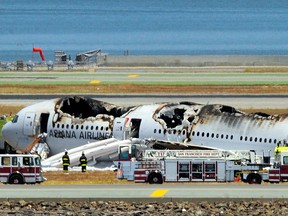
SAN FRANCISCO — Officials investigating a jetliner crash in San Francisco have determined that Asiana Airlines Flight 214 was traveling "significantly below" the target speed during its arroyo and that the crew tried to abort the landing only before it smashed onto the rails. What they don't however know is whether the pilot's inexperience with this blazon of aircraft and at this aerodrome played a role.
A solar day subsequently the jetliner crash landed in San Francisco, killing 2 people and sending more than than 180 to hospitals, officials said Sunday that the probe was also focusing on whether the airport or airplane's equipment could accept also malfunctioned.
The South korea government announced Monday that officials will inspect engines and landing equipment on all Boeing 777 planes endemic past Asiana and Korean Air, the national carrier.
Also Sunday, San Mateo County Coroner Robert Foucrault said he was investigating whether one of the two teenage passengers killed actually survived the crash but was run over past a rescue vehicle rushing to aid victims fleeing the burning aircraft. Remarkably, 305 of 307 passengers and crew survived the crash and more a tertiary didn't even crave hospitalization. Only a pocket-sized number were critically injured.
Investigators said that the weather was unusually fair for foggy San Francisco. The winds were mild, too. During the descent, with their throttles set to idle, the pilots never discussed having any issues with the plane or its positioning until it was too tardily.
Vii seconds before the Boeing 777 struck down, a fellow member of the flight coiffure fabricated a call to increase the jet's lagging speed, National Transportation Safety Board chief Deborah Hersman said at a conference based on the plane's cockpit and flight data recorders. Three seconds later came a alert that the engines were about to stall.
Two-and-a-one-half seconds subsequently, the coiffure attempted to abort the landing and go back up for some other try. The air traffic controller guiding the plane heard the crash that followed almost instantly, Hersman said.
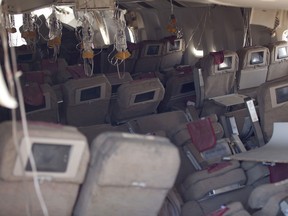
While investigators from both the U.Southward. and Republic of korea are in the early on stages of an investigation that will include a weeks-long exam of the wreckage and alcohol tests for the crew, the news confirmed what survivors and other witnesses had reported: a slow-moving airliner flying low to the ground.
"Nosotros are not talking about a few knots" departure between the aircraft's target landing speed of 137 knots per hour, or 157 mph, and how fast it was going as it came in for a landing, Hersman said.
Pilots normally try to land at the target speed, in this case 137 knots, plus an boosted v more than knots, said Bob Coffman, an American Airlines captain who has flown 777s. He said the briefing raises an important question: "Why was the plane going so slow?"
The airline said Monday in Seoul that the airplane pilot at the controls had niggling feel flight that type of airplane and was landing one for the outset time at that airport. The captain was on his ninth landing in a Boeing 777. Pilots need 60 hours and 10 landing to be considered fully training.
Asiana spokeswoman Lee Hyomin said that Lee Gang-guk, who was at the controls, had nearly 10,000 hours flying other planes but merely 43 in the 777, a airplane she said he still was getting used to flight. Some other pilot on the flying, Lee Jeong-min, had about 12,390 hours of flying feel, including three,220 hours on the 777, according to the Ministry of Land, Infrastructure and Ship in Southward Korea. Lee was the deputy pilot, tasked with helping Lee Gang-guk get accepted to the 777, according to Asiana Airlines.
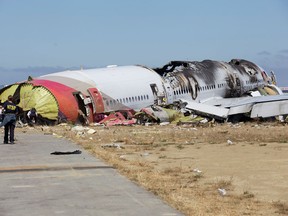
Two other pilots were aboard, with teams of rotating at the controls.
The plane's Pratt & Whitney engines were on idle and the pilots were flying nether visual flying rules, Hersman said. Under visual flight procedures in the Boeing 777, a wide-torso jet, the autopilot would typically accept been turned off while the automatic throttle, which regulates speed, would been on until the plane had descended to 500 feet in altitude, Coffman said. At that point, pilots would normally check their airspeed before switching off the autothrottle to continue a "manus wing" approach, he said.
At that place was no indication in the discussions betwixt the pilots and the air traffic controllers that there were issues with the aircraft.
Survivors and rescuers said it was nothing less than astonishing that nearly everyone survived after a frightful scene of burn down called-for within the fuselage, pieces of the aircraft scattered beyond the runway and people fleeing for their lives.
In the first comments on the crash by a coiffure fellow member, cabin managing director Lee Yoon-hye said that seconds earlier impact she felt that something was incorrect.
"Right before touchdown, I felt like the airplane was trying to have off. I was thinking `what'southward happening?' and and so I felt a bang," Lee told reporters Sunday night in San Francisco. "That blindside felt harder than a normal landing. Information technology was a very large shock. Subsequently, in that location was another daze and the plane swayed to the correct and to the left."
She said that during the evacuation, two inflatable slides that were supposed to inflate toward the outside, inflated toward the inside of the aeroplane, hurting two Asiana flight attendants. Pilots came to rescue the flight attendants only even after getting injured, she said that the crew did not leave the airplane until afterward the passengers evacuated. She said she was the last ane to get.
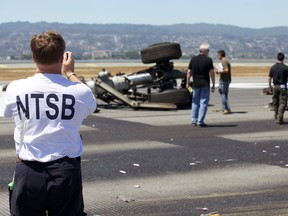
The 2 dead passengers take been identified as students from China -16 and 17 years sometime- who were scheduled to nourish summertime camp in California with dozens of classmates. Hospital officials said Sunday that two of the people who remained hospitalized in critical condition were paralyzed with spinal injuries, while some other two showed "road rash" injuries consistent with being dragged.
Foucrault, the coroner, said one of the bodies was constitute on the tarmac near where the plane's tail broke off when it slammed into the runway. The other was found on the left side of the aeroplane most 30 feet away from where the jetliner came to rest after it skidded downward the runway. Foucrault said an autopsy he expects to be completed by Mon will involve determining whether the second girl's death was caused by injuries suffered in the crash or "a secondary incident."
He said he did not get a close plenty await at the victims on Sat to know whether they had external injuries.
The flight originated in Shanghai, China, and stopped over in Seoul, Republic of korea, earlier making the most 11-60 minutes trip to San Francisco.
On sound recordings from the air traffic belfry, controllers told all pilots in other planes to stay put after the crash. "All runways are airtight. Airport is closed. San Francisco belfry," said 1 controller.
At one point, the pilot of a United Airlines plane radioed.
"We see people … that demand immediate attention," the pilot said. "They are alive and walking around."
"Think you said people are just walking outside the airplane right now?" the controller replied.
"Yeah," answered the pilot of United Flight 885. "Some people, it looks similar, are struggling."
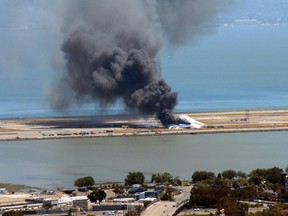
When the plane hitting the ground, oxygen masks dropped down, said Xu Da, a product manager at an Cyberspace visitor in Hangzhou, Cathay, who was sitting with his wife and teenage son near the back of the plane. He stood upward and saw sparking – peradventure from exposed electrical wires – and a gaping hole through the back of the aeroplane where its galley was torn away along with the tail.
Xu and his family unit escaped through the opening. Once on the tarmac, they watched the plane catch fire, and firefighters hose it down.
In the chaotic moments after the landing, when baggage was tumbling from the overhead bins onto passengers and people all around her were screaming, Wen Zhang grabbed her four-year-old son, who hit the seat in front of him and broke his leg.
Spotting a hole at the dorsum of the jumbo jet where the bathroom had been, she carried her boy to safety.
"I had no fourth dimension to be scared," she said.
Nearby, people who escaped were dousing themselves with water from the bay, possibly to cool burn injuries, authorities said.
By the time the flames were out, much of the top of the fuselage had burned away. Within The tail section was gone, with pieces of it scattered beyond the kickoff of the rails. I engine was gone, and the other was no longer on the fly.
Source: https://nationalpost.com/news/plane-that-crashed-in-san-francisco-was-flying-too-slow-captain-was-in-training-on-boeing-777

Belum ada Komentar untuk "Airline Captain - You Will Not Regret Reading This One. I Promise!"
Posting Komentar